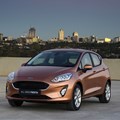#TriedAndTested: New Nissan Micra

Even though the recent rain in the Cape is much appreciated, it isn't the ideal conditions for a supermini car launch. Luckily our rotation was on the Friday, which evidently meant less wind and rain than the previous day, but we were still rerouted due to a closed mountain pass.
What's it like?
The Nissan Micra has undergone a complete transformation from cute and bubbly to downright sophisticated and sexy.
My one colleague actually pointed out that he thinks it resembles the new X-Trail's profile.
Sure, it's two very different cars, but the same DNA results in definite similarities such as the striking V-motion grille at the front, narrow headlamps which stretch through the front wings and include LED daytime running lights, as well as the boomerang-shaped light clusters at the rear.
I, for one, am all too happy to wave the bubble shape and those round lights of the previous generation farewell.

![Old bubble shape. By OSX [Public domain], from Wikimedia Commons](https://biz-file.com/c/1806/446103-700x364.jpg)
These elements, along with the rest of the car's carefully considered exterior design, gives it a bold, athletic look - as if it's ready to take on any challenge. It might not be able to take on any challenge, but it will sure give it a good go.
We drove off in a funky "energy orange" Micra - its cabin comfortable and high-quality with two-tone soft-touch materials. The boot capacity is on par with competitiors at 300 litres (which can expand to 1,004 litres when the 60:40 split rear seats are folded down).
The seven-inch touch-screen colour display on the Acenta and Acenta Plus gives access to music, messages and maps through Apple CarPlay in addition to the MP3, USB and Bluetooth in the Visia model.

How about engine and safety stuff?
The turbo-charged petrol engine pushes out 66kW of power and140Nm of torque.
Overall, I felt rather safe in this hot hatchback, considering the terrain and weather conditions. The new Micras come with six airbags as standard, plus seat belt warnings and seat belt height adjustment for the front and rear.
Isofix child seats are standard, including in the front passenger seat. Electronic safety systems include vehicle dynamic control, anti-locking braking system, electronic brake force distribution and hill start assist.
What else?
The new Micra has an overall length of 3,999mm, allowing it to just slide into the supermini segment.

As with the new Suzuki Swift, the Micra's wheels have been placed right in the corners of the car to make the most of space. The black B and C-pillars create a floating roof effect, while the C-pillar is home to the discrete door handles which provide access for rear passengers (here's that trend again which I mentioned in my review of the Swift).
Nissan says the range will be expanded in 2019 to include additional derivatives such as the 1.0. Spec. Price will be confirmed next year.
How many bucks?
The Micra is covered by Nissan Assured and comes with a six-year/150,000km warranty; a three-year/90,000km service plan; and 24/7 roadside assistance.
- Nissan Micra Visia: R233,500
- Nissan Micra Acenta: R257,400
- Nissan Micra Acenta Plus: R272,400
Conclusion
Nissan is not doing away with its contender in the lower B hatchback segment, the Micra Active. It will continue to be sold alongside the all-new Micra, which will surely make its mark in the popular upper B hatchback segment - taking on the likes of the new Ford Fiesta and the VW Polo. I think it wil gain good traction thanks to the value for money offering. Well done, Nissan, well done.






















